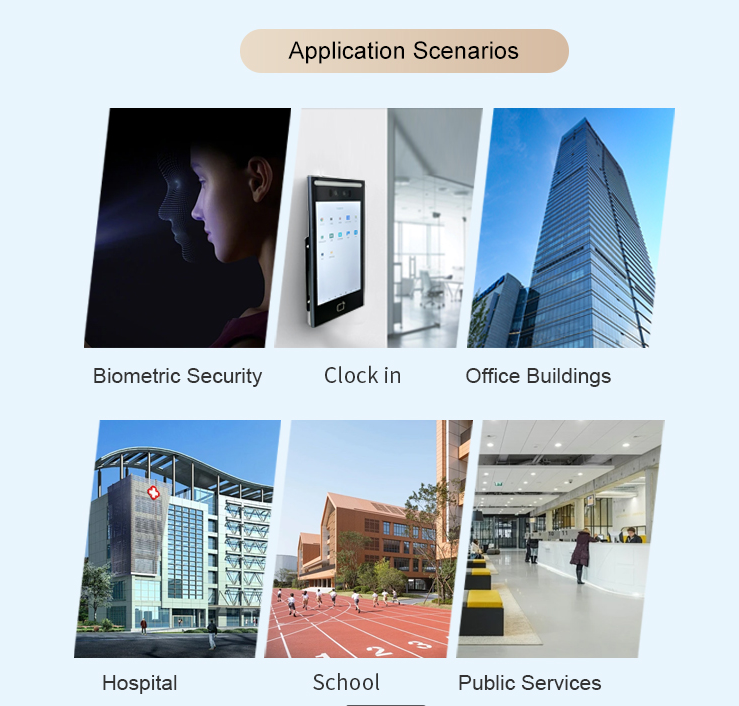Hey, Today we’re going to talk about something super cool: the application of facial recognition technology in access control systems. Do you remember the first time you unlocked your door with your face? I remember it clearly, it felt like stepping into the future!

The basic principle of facial recognition technology is actually very simple: it confirms your identity by analyzing the unique features of your face. Imagine that your face is like a unique key, and the access control system is a smart lock. Cool or not?
The application of facial recognition technology in access control has come a long way. I still remember visiting a high-tech park a few years ago and seeing that they had just installed a facial recognition access control system. I thought it was very advanced at the time, but now I think that system is “kindergarten-level” compared to the current one!
In corporate office environments, facial recognition access control systems are gradually replacing traditional access cards. I have a friend who works in a technology company, and their company recently upgraded its facial recognition system. He told me that he no longer has to worry about forgetting to bring his access card, which feels very convenient.
For government agencies and some high-security places, facial recognition technology provides a higher level of security. I once visited a data center, and their facial recognition system not only recognized the identity, but also detected whether someone was coerced. This made me sigh that technology is really amazing!
Facial recognition technology also shows its prowess in smart home systems. Imagine that when you return home, the door will automatically open for you, and the lights and temperature will automatically adjust according to your preferences. I recently installed such a system at home, and every time I go home, I feel like a VIP!
With facial recognition technology, entering and exiting becomes super convenient. No need to take out a card or enter a password, just “scan your face”. I experienced it at a large conference, and it only took a few minutes for hundreds of people to enter. It was so cool!
Compared with traditional access card or password systems, facial recognition technology is much more secure. Unless you have a twin (even if you have twins, many advanced systems can tell the difference), it is difficult for others to impersonate you.
During this special period, contactless operation has become particularly important. Facial recognition technology just meets this need. I recently went to the hospital for a check-up and passed through “contactless” throughout the whole process, which made me feel particularly at ease.
Although facial recognition technology is very advanced, it still has recognition difficulties in some cases. For example, in places with extremely dark or strong light, or when the angle is wrong, recognition may fail. I have encountered the embarrassing situation of being “ignored” by the system when wearing sunglasses.
The new crown epidemic has brought new challenges to facial recognition technology. When wearing a mask, the system may not work properly. However, the good news is that many companies are developing new algorithms that can recognize faces wearing masks.
Speaking of privacy, this may be the biggest controversy of facial recognition technology. After all, your face is one of the most private biometrics. I have a friend who insists on not using facial recognition because of privacy concerns.
With the development of artificial intelligence technology, facial recognition algorithms are becoming more and more intelligent. Today's systems can not only recognize static images, but also analyze dynamic expressions and micro-expressions. A system I recently participated in testing can even determine whether the user is in a state of tension. It's amazing!
The application of 3D sensors has greatly improved the accuracy of facial recognition. It can capture the three-dimensional structure of the face, making the recognition more accurate and harder to be deceived by photos or videos.
Future access control systems may combine multiple biometric technologies, such as using facial, fingerprint and voiceprint recognition at the same time. This is not only safer, but also adaptable to more scenarios.
In order to protect user privacy, facial recognition systems usually encrypt and store the collected data. Some advanced systems do not even store the original image, but only save feature point data.
Giving users more control is also a way to protect privacy. For example, allowing users to delete their facial data at any time, or choose not to use facial recognition in certain situations.
In the future, facial recognition technology may be deeply integrated with artificial intelligence and IoT technology. Imagine that when you walk into the office, the system can not only recognize your identity, but also judge your mood based on your expression, and automatically adjust the office environment to improve your work efficiency.
Some studies are exploring the integration of emotion recognition technology into access control systems. This may sound a bit sci-fi, but think about it, if the system can recognize whether you are in a state of tension or anxiety, it can take corresponding security measures in time, isn’t it cool?
The application of facial recognition technology in access control systems is undoubtedly an exciting field. It not only makes our lives more convenient and safer, but also opens up unlimited possibilities. Of course, while enjoying the convenience brought by this technology, we also need to be vigilant about possible risks, especially in terms of privacy protection.
In any case, the application of facial recognition technology in access control systems has just begun. Let us look forward to its future development and witness more amazing innovations!